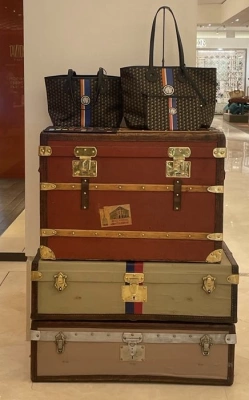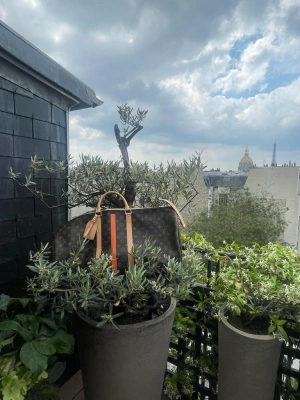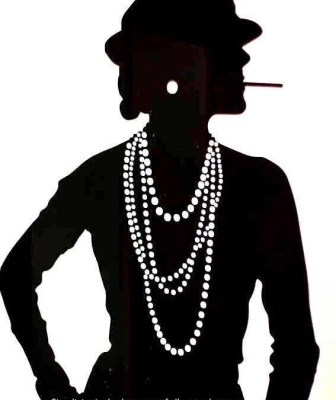Are you sure you want to perform this action?
Asnières, the beating heart of Louis Vuitton
Have the privilege to visit this magical place on a private tour and the magic happens immediately. You might even say you fall under its spell.
This emblematic site in the Paris region combines the Art Nouveau-style family home of the founder Louis Vuitton, the traditional trunk-making workshops and a completely renovated gallery space.
The Asnières site remains the heart and soul of Louis Vuitton even 170 years after its birth.
The family house, built in 1860 next to the typical Eiffel-era workshops, is like a journey back in time, where nothing has changed for more than a century and a half.
Photos of all 5 generations are displayed on the pedestal table in the winter garden lounge. They show Louis, the founder, and his wife Clémence - Emilie Parriaux, their son Georges, who took over in 1892, Gaston, the grandson, and Patrick-Louis Vuitton, who ran the Asnières workshop and special orders until his death in 2019.
Vuitton is a true family saga.
Who would ever have believed that Louis Vuitton, a native of the Jura from a very simple background who moved to Paris in the late 1830s, would create a brand that is still so famous and recognised 170 years after its creation.
His credo: at the time of the first journeys and the steam engine, he had the idea of creating stackable trunks, covered in canvas to be more functional and resistant.
That's what we call being visionary, but it's also about being bold. That's the key to success.
As for the workshops, they're a closely guarded secret!
Related articles
The history of luggage dates back to ancient times, when people used cloth bags or woven baskets to carry their belongings. However, these bags were often bulky and impractical to carry over long distances.
Over the centuries, luggage evolved to become more functional and adapted to travellers' needs. In the Middle Ages, nobles used wooden chests to carry their belongings when travelling. These chests were often heavy and required several people to carry them.
With the advent of rail and sea travel in the 19th century, luggage underwent a new evolution. Wooden trunks became popular, offering better protection for fragile objects. These trunks were often adorned with leather or canvas and were used by wealthy travellers.
In the 20th century, the arrival of commercial aviation led to a further transformation of luggage. Rigid metal or plastic suitcases became common, offering greater shock resistance and storage capacity. Wheels were also added to make transport easier.
Today, luggage is available in a wide variety of shapes, sizes and materials. Many models are available from Les Malletiers....
Louis Vuitton's Keepall travel bag, the 1930s... Cruises were fashionable, as were holidays in Deauville and Biarritz.
At that time, Louis Vuitton, renowned for its trunks, had to adapt to these new lifestyles. The result was the Keepall, a bag that "keeps everything". The Keepall is a flexible, zipped bag made from the famous monogrammed coated canvas. Its generous shape allows you to slip in a sports outfit and a few simple clothes for a weekend in the countryside.
An immediate success, the Keepall has never left the Louis Vuitton catalogue. It has been used in the trunk-maker's other collections, and given a new look by artists invited by Marc Jacobs, including Takashi Murakami and others.
Four sizes were chosen (45, 50, 55 and 60 cm), with the first three being the most popular because they could be carried in the cabin.
Seen over and over again on all the people for generations, the Keepall is now a timeless piece, which we keep, cherish and watch lovingly polish... Les Malletiers loves it too!
Coco Untold Stories, the early years...
She symbolizes French elegance. Gabrielle Chanel, born in Saumur in 1883, whose real name was Gabrielle Chasnel, was raised in an orphanage. At the age of 12, she was taken in with two of her sisters at Aubazine Abbey in Corrèze.
Her mother died in Brive-la-Gaillarde in 1895. When she was just 12, her father abandoned her a few months later, to the care of the nuns. He never returned. Gabrielle went to Aubazine to learn sewing. She stayed for 6 years. The abbey would remain a powerful source of inspiration for the codes of the House of Chanel...
Coco Chanel's taste for clean lines and her predilection for black, white and beige are perhaps linked to the sobriety of the abbey and its occupants...
Once she left Aubazine, she moved to Moulin. Gabrielle had to earn a living, so she sang in small shows in bars, famous for her rendition of
“Who has seen Coco on the Trocadero? Coco, a nickname that has stuck for posterity...





